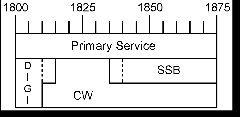160 metres
Related wiki pages Bands, Propagation Antenna
| Band: 160 meters | |
| Bands | |
| 160m 80m 60m 40m 30m 20m 17m 15m 12m 10m 6m 4m 2m 1.25m 70cm 33cm 23cm 3cm | |
| Band Privileges | |
| US Extra | 1.800-2.000 |
| US Advanced | 1.800-2.000 |
| US General | 1.800-2.000 |
| US Technician | None |
| UK (all) | {{{UK}}} |
160 metres, often known as Top Band, is technically a Medium Frequency (MF) band, the only one licensed to amateurs. It is slightly higher in frequency than the AM broadcast band (540 kHz - 1600 kHz), and behaves similarly. 160 meters is the lowest-frequency band on which amateurs are licensed to operate.
Equipment
Most amateur HF equipment supports the 160 metre band. However, it can be challenging to put up a full-size antenna on this band. Many operators use an inverted-L antenna for 160.
Modulation
Operation on the 160 metre band is primarily CW and SSB, but operators also use modes appropriate for HF such as RTTY and SSTV.
Propagation
Radio communication on 160 metres is prone to extreme D-layer absorption during the day. This typically limits communication to 75 miles. At night, however, the D-layer weakens and contacts can be mode over thousands of kilometres. Like the HF bands, 160 metres usually supports such long-distance communication through refraction of signals via the F2 layer.
Australian Bandplan
Access : Advanced licencees only
1.800 - 1.810MHz Digital modes
1.810 - 1.840MHz CW only
1.840 - 1.875MHz SSB/AM
